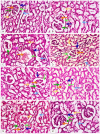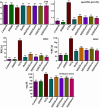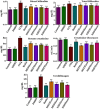Nephroprotective Effects of Fraxinus Hookeri Wenz. Against Renal Toxicity and DNA Oxidative Damages Induced by CCl4 in Rats
- PMID: 40518992
- PMCID: PMC12368880
- DOI: 10.1002/open.202400515
Nephroprotective Effects of Fraxinus Hookeri Wenz. Against Renal Toxicity and DNA Oxidative Damages Induced by CCl4 in Rats
Abstract
Recognizing the therapeutic value of the Genus Fraxinus worldwide, this study evaluates the antioxidant potential of Fraxinus hookeri Wenz. (F. hookeri) against CCl4-induced nephrotoxicity in rats. Forty-eight rats are randomly allocated into eight groups (six rats each). Antioxidant enzymes, genotoxicity, urine and serum markers, and tissue histopathology are assessed to determine their nephroprotective effects. The Control group remains untreated, while the DMSO group receives vehicle olive oil intraperitoneally and DMSO orally (3 ml/kg). All other groups, except Control and DMSO, are given CCl4 (3 ml/kg, i.p., in 30% olive oil) twice weekly for 4 weeks. The CCl4 group receives only CCl4. The Rutin group receives reference drug Rutin orally (50 mg/kg). MEFH100 and MEFH200 groups are given MEFH at 100 and 200 mg/kg, respectively, and NHFH100 and NHFH200 receive NHFH at the same doses. Rutin and F. hookeri treatment effectively (P < 0.05) restore urine and serum markers disrupted by CCl4. CCl4 reduced (p < 0.05) antioxidant enzymes (CAT, SOD, POD) and increased TBAR levels and DNA damage, which are reversed by cotreatment with F. hookeri and Rutin. Histopathological improvements (P < 0.05) are also observed with F. hookeri. The results indicate that F. hookeri enhances antioxidant defenses, supporting its potential against CCl4-induced nephrotoxicity.
Keywords: Fraxinus hookeri; CCl4; genotoxicity; histopathology; nephroprotective; nephrotoxicity; renal.
© 2025 The Author(s). ChemistryOpen published by Wiley‐VCH GmbH.
Conflict of interest statement
The authors declare no conflicts of interest. The funders had no role in the design of the study; in the collection, analyzes, or interpretation of data; in the writing of the manuscript; or in the decision to publish the results.
Figures








Similar articles
-
Protective effects of Rosa canina fruit extract against kidney damage induced by CCl4.Regul Toxicol Pharmacol. 2025 Nov;162:105913. doi: 10.1016/j.yrtph.2025.105913. Epub 2025 Jul 18. Regul Toxicol Pharmacol. 2025. PMID: 40685065
-
Protective effects of Fraxinus xanthoxyloides (Wall.) leaves against CCl4 induced hepatic toxicity in rat.BMC Complement Altern Med. 2016 Oct 24;16(1):407. doi: 10.1186/s12906-016-1398-0. BMC Complement Altern Med. 2016. PMID: 27776508 Free PMC article.
-
HPLC-MS profiling and protective potential of the defatted aqueous methanol extract of two Syzygium species against cadmium chloride-induced nephrotoxicity in rats.PLoS One. 2025 Aug 14;20(8):e0329586. doi: 10.1371/journal.pone.0329586. eCollection 2025. PLoS One. 2025. PMID: 40811634 Free PMC article.
-
Iron overload induced submandibular glands toxicity in gamma irradiated rats with possible mitigation by hesperidin and rutin.BMC Pharmacol Toxicol. 2024 Feb 27;25(1):22. doi: 10.1186/s40360-024-00744-8. BMC Pharmacol Toxicol. 2024. PMID: 38414079 Free PMC article.
-
The Black Book of Psychotropic Dosing and Monitoring.Psychopharmacol Bull. 2024 Jul 8;54(3):8-59. Psychopharmacol Bull. 2024. PMID: 38993656 Free PMC article. Review.
References
MeSH terms
Substances
Grants and funding
LinkOut - more resources
Full Text Sources
Medical
Miscellaneous

